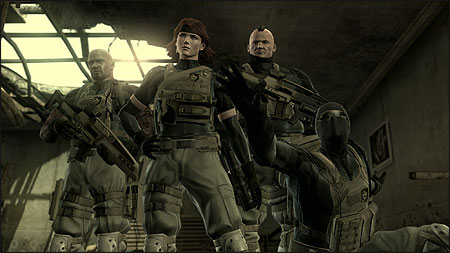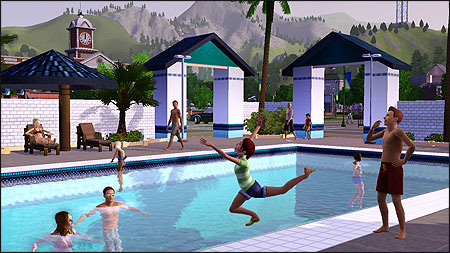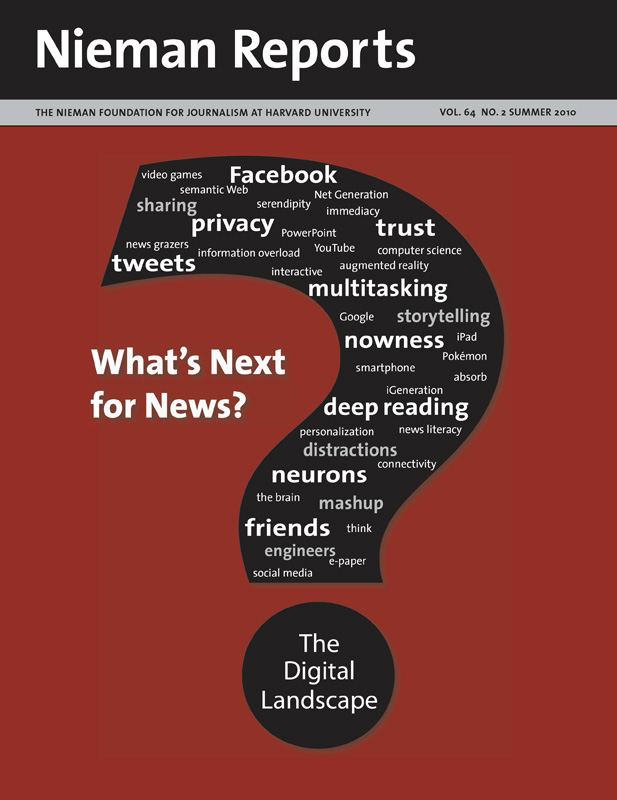In our interconnected world, what does it take to understand issues like climate change or the global economic meltdown or events such as conflict in the Middle East? Traditionally we have used news reporting and documentaries as well as novels. Another name for such providers is content-driven media, which strings together facts or fictions to report on events or tell us stories.
Video games are not content-driven media though they do have content. They are driven by choices and problem solving. Content is there to motivate player choices about how to solve problems. Our understanding or illumination comes through solving problems or trying to solve them or by realizing there are multiple ways to solve them. Perhaps the problem is how to wage war in contemporary global conflicts (Full Spectrum Warrior), sneak past enemies (Metal Gear Solid), manage a city (SimCity) or a civilization (Civilization), or clean house and keep a family happy when you are a four-inch robot (Chibi-Robo).
Learning Changes
Our expectation is similar with these different kinds of media; we expect to learn new things, whether the source is news, novels, textbooks, movies or games. But we learn differently from content-driven media than we do from media driven by choice and problem solving. In content-driven media we learn by being told and reflecting on what we are told. Of course it is not always easy to ensure that reflection happens and some content producers—especially in our polarized and entertainment-driven media—do not encourage wide-ranging reflections on all sides of an issue.
With games, we learn best from a well-designed guided experience. This means inhabiting virtual worlds that guide players to make choices, solve problems, and reflect on the results. Players have to reflect because their choices affect whether they win or lose.
Game designers create digital environments and game levels that shape, facilitate and, yes, teach problem solving. For example, after playing Chibi-Robo I know how to clean a house when you are only four inches tall and I know how the world looks to a four-inch robot and what dilemmas he faces. In a real-time strategy game like Rise of Nations, players have to make a decision like, “Should my civilization invest in technology now or wait 500 years?”. In Portal, a player has to think about how the laws of physics—for example the law of conservation of momentum—can be used to manipulate the environment. In Tactical Iraqi, a game that is marketed for military and diplomatic training, the player must be a soldier in Iraq and learn to speak Iraqi Arabic in realistic settings without culturally insulting anyone.
We learn from games quite differently than we do from news and books. And we also learn from games quite differently than we learn in school where failure is a big deal. Not so in games; just start over from the last save. A low cost for failure ensures that players will take risks, explore and try new things.
Games are based on performance before competence: learn by doing, then read. School often is based on competence before performance: learn by reading, then maybe you get to do. Players are able to understand manuals and strategy guides because they have experience with the game. In school, too often, students have not lived in the worlds described by the books they are reading (i.e., they have not “played” the game of biology, but only read about it).
Games let players practice skills as part of larger goals they want to accomplish; in school, kids are often skilled and drilled apart from any meaningful context. Games make players master skills through practice and then challenge that mastery with a “boss battle,” forcing the player to learn something new and take mastery to the next stage. School can be too challenging if kids are never allowed to practice enough to attain mastery. Alternatively, schools too often fail to challenge the routine mastery of kids who get good grades.
Finally, games encourage players to think about how they are designed—in order to beat them—and even to design games themselves through “modding,” in which they use tools that often come with games to make new levels or entirely new games. Schools rarely let kids design or redesign the curriculum.

When players engage in the Metal Gear series their goal is to solve problems, escape enemies, and survive.
Be Told or Be Involved
An example of this learning dichotomy can be found in a book and a game about what it is like to be poor. Barbara Ehrenreich, in her book “Nickel and Dimed,” tells what it is like to be poor by describing how hard a time she had, as a middle-class well-educated person, trying to get and keep low-level service jobs. She shows us how she tried to solve problems, and as readers we are meant to learn through her experiences.
On the other hand, players in The Sims, which is the best-selling PC game of all time, can challenge each other to see if they can survive as a poor single parent and get their kids safely out of the house into young adulthood and college. This isn’t easy to do in the game, which contains lots of rules about what players can and cannot do in order to simulate the feel and difficulty of poverty.
In assuming such a challenge, players learn by facing the problems themselves, as Ehrenreich did. And they can win or lose. One rule is that players cannot reverse a decision (e.g., quit a play session without saving the results), even if bad things have happened or they’ve made bad choices. They have to live with the bad things. Of course, people cannot quit without “saving” what has happened ; they have to live with the consequences of what they’ve done or what has happened to them. Players are not learning from someone else’s experience; they are learning from their own.
Yet these players are learning something beyond what it means to be poor; they are learning that solving problems (such as poverty—or it could be global warming) depends a lot on how the problem is set up and what the rules are. Call them constraints, if you like. Along the way, they discover that poverty is a system and that there are different ways to view or simulate (or discuss) that system.
At a time of polarized, entertainment-driven newspapers and in a world replete with risky, dangerous and complex systems, maybe it is better to make a game as a way for people to engage and learn than it is to write or broadcast a report.
Journalism is part of a content-driven media world. Both a news story and a novel are meant to inform us and perhaps move us emotionally. Maybe the novel offers a deeper understanding than a more ephemeral news story but in both cases content is being used to make us learn, think, know and perhaps feel.
Games are about things, too, and have content; for example, the infamous Grand Theft Auto series of games is about crime. Sometimes games have elaborate stories, sometimes they don’t. But games are not about their content in the way that a newscast or a novel is about its content. Games are about problems to be solved by the player and the content is there only to establish what the problems are or to motivate players to solve them.
In one of the Grand Theft Auto games the player must sneak into a parking lot and, unseen, plant a bomb in the trunk of a car and leave the scene without doing damage to the getaway car. Our intuition about content-driven media tells us that this is about a crime but the task could be changed to placing flowers in a loved one’s car without being discovered, and the problem and its difficulty would be the same. What matters are the problems and how a player responds.
What makes a game good is not content but the problems players solve and how they do so. If content contributes to this effort in ways that motivate, then it’s good to have. Otherwise it is detrimental to the game or, at best, a distraction. Digital media enable journalists to devise games as a platform for sharing news. Doing this, however, requires not only knowing how to use the technology to create effective games but recognizing that the player’s ability to absorb the information will likely rely more on what he does than what he reads.

The Sims, which is the best-selling computer game, offers players open-ended scenarios that mimic the challenges of real life.
James Paul Gee is the Mary Lou Fulton Presidential Professor of Literacy Studies at Arizona State University, author of “What Video Games Have to Teach Us About Learning and Literacy” and coauthor of “Women and Gaming: The Sims and 21st Century Learning,” both published by Palgrave Macmillan.
Video games are not content-driven media though they do have content. They are driven by choices and problem solving. Content is there to motivate player choices about how to solve problems. Our understanding or illumination comes through solving problems or trying to solve them or by realizing there are multiple ways to solve them. Perhaps the problem is how to wage war in contemporary global conflicts (Full Spectrum Warrior), sneak past enemies (Metal Gear Solid), manage a city (SimCity) or a civilization (Civilization), or clean house and keep a family happy when you are a four-inch robot (Chibi-Robo).
Learning Changes
Our expectation is similar with these different kinds of media; we expect to learn new things, whether the source is news, novels, textbooks, movies or games. But we learn differently from content-driven media than we do from media driven by choice and problem solving. In content-driven media we learn by being told and reflecting on what we are told. Of course it is not always easy to ensure that reflection happens and some content producers—especially in our polarized and entertainment-driven media—do not encourage wide-ranging reflections on all sides of an issue.
With games, we learn best from a well-designed guided experience. This means inhabiting virtual worlds that guide players to make choices, solve problems, and reflect on the results. Players have to reflect because their choices affect whether they win or lose.
Game designers create digital environments and game levels that shape, facilitate and, yes, teach problem solving. For example, after playing Chibi-Robo I know how to clean a house when you are only four inches tall and I know how the world looks to a four-inch robot and what dilemmas he faces. In a real-time strategy game like Rise of Nations, players have to make a decision like, “Should my civilization invest in technology now or wait 500 years?”. In Portal, a player has to think about how the laws of physics—for example the law of conservation of momentum—can be used to manipulate the environment. In Tactical Iraqi, a game that is marketed for military and diplomatic training, the player must be a soldier in Iraq and learn to speak Iraqi Arabic in realistic settings without culturally insulting anyone.
We learn from games quite differently than we do from news and books. And we also learn from games quite differently than we learn in school where failure is a big deal. Not so in games; just start over from the last save. A low cost for failure ensures that players will take risks, explore and try new things.
Games are based on performance before competence: learn by doing, then read. School often is based on competence before performance: learn by reading, then maybe you get to do. Players are able to understand manuals and strategy guides because they have experience with the game. In school, too often, students have not lived in the worlds described by the books they are reading (i.e., they have not “played” the game of biology, but only read about it).
Games let players practice skills as part of larger goals they want to accomplish; in school, kids are often skilled and drilled apart from any meaningful context. Games make players master skills through practice and then challenge that mastery with a “boss battle,” forcing the player to learn something new and take mastery to the next stage. School can be too challenging if kids are never allowed to practice enough to attain mastery. Alternatively, schools too often fail to challenge the routine mastery of kids who get good grades.
Finally, games encourage players to think about how they are designed—in order to beat them—and even to design games themselves through “modding,” in which they use tools that often come with games to make new levels or entirely new games. Schools rarely let kids design or redesign the curriculum.

When players engage in the Metal Gear series their goal is to solve problems, escape enemies, and survive.
Be Told or Be Involved
An example of this learning dichotomy can be found in a book and a game about what it is like to be poor. Barbara Ehrenreich, in her book “Nickel and Dimed,” tells what it is like to be poor by describing how hard a time she had, as a middle-class well-educated person, trying to get and keep low-level service jobs. She shows us how she tried to solve problems, and as readers we are meant to learn through her experiences.
On the other hand, players in The Sims, which is the best-selling PC game of all time, can challenge each other to see if they can survive as a poor single parent and get their kids safely out of the house into young adulthood and college. This isn’t easy to do in the game, which contains lots of rules about what players can and cannot do in order to simulate the feel and difficulty of poverty.
In assuming such a challenge, players learn by facing the problems themselves, as Ehrenreich did. And they can win or lose. One rule is that players cannot reverse a decision (e.g., quit a play session without saving the results), even if bad things have happened or they’ve made bad choices. They have to live with the bad things. Of course, people cannot quit without “saving” what has happened ; they have to live with the consequences of what they’ve done or what has happened to them. Players are not learning from someone else’s experience; they are learning from their own.
Yet these players are learning something beyond what it means to be poor; they are learning that solving problems (such as poverty—or it could be global warming) depends a lot on how the problem is set up and what the rules are. Call them constraints, if you like. Along the way, they discover that poverty is a system and that there are different ways to view or simulate (or discuss) that system.
At a time of polarized, entertainment-driven newspapers and in a world replete with risky, dangerous and complex systems, maybe it is better to make a game as a way for people to engage and learn than it is to write or broadcast a report.
Journalism is part of a content-driven media world. Both a news story and a novel are meant to inform us and perhaps move us emotionally. Maybe the novel offers a deeper understanding than a more ephemeral news story but in both cases content is being used to make us learn, think, know and perhaps feel.
Games are about things, too, and have content; for example, the infamous Grand Theft Auto series of games is about crime. Sometimes games have elaborate stories, sometimes they don’t. But games are not about their content in the way that a newscast or a novel is about its content. Games are about problems to be solved by the player and the content is there only to establish what the problems are or to motivate players to solve them.
In one of the Grand Theft Auto games the player must sneak into a parking lot and, unseen, plant a bomb in the trunk of a car and leave the scene without doing damage to the getaway car. Our intuition about content-driven media tells us that this is about a crime but the task could be changed to placing flowers in a loved one’s car without being discovered, and the problem and its difficulty would be the same. What matters are the problems and how a player responds.
What makes a game good is not content but the problems players solve and how they do so. If content contributes to this effort in ways that motivate, then it’s good to have. Otherwise it is detrimental to the game or, at best, a distraction. Digital media enable journalists to devise games as a platform for sharing news. Doing this, however, requires not only knowing how to use the technology to create effective games but recognizing that the player’s ability to absorb the information will likely rely more on what he does than what he reads.

The Sims, which is the best-selling computer game, offers players open-ended scenarios that mimic the challenges of real life.
James Paul Gee is the Mary Lou Fulton Presidential Professor of Literacy Studies at Arizona State University, author of “What Video Games Have to Teach Us About Learning and Literacy” and coauthor of “Women and Gaming: The Sims and 21st Century Learning,” both published by Palgrave Macmillan.




